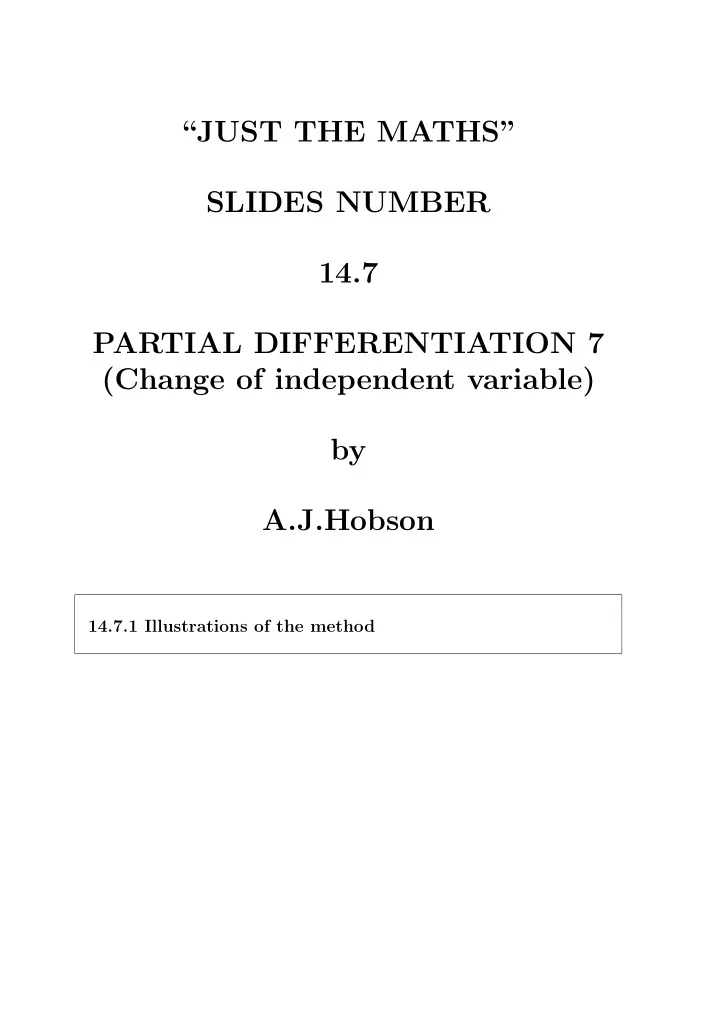

“JUST THE MATHS” SLIDES NUMBER 14.7 PARTIAL DIFFERENTIATION 7 (Change of independent variable) by A.J.Hobson 14.7.1 Illustrations of the method
UNIT 14.7 PARTIAL DIFFERENTIATON 7 CHANGE OF INDEPENDENT VARIABLE 14.7.1 ILLUSTRATIONS OF THE METHOD The following technique would be necessary, for example, in changing from one geometrical reference system to an- other, especially with “partial differential equations” . The method is an application of the chain rule for partial derivatives and is illustrated with examples. EXAMPLES 1. Express, in plane polar co-ordinates, r and θ , the fol- lowing partial differential equations: (a) ∂V ∂x + 5 ∂V ∂y = 1; (b) ∂ 2 V ∂x 2 + ∂ 2 V ∂y 2 = 0 . 1
Solution Both differential equations involve a function, V ( x, y ), where x = r cos θ and y = r sin θ. Hence, ∂V ∂r = ∂V ∂x .∂x ∂r + ∂V ∂y .∂y ∂r, or ∂V ∂r = ∂V ∂x cos θ + ∂V ∂y sin θ and ∂V ∂θ = ∂V ∂x .∂x ∂θ + ∂V ∂y .∂y ∂θ, or ∂V ∂θ = − ∂V ∂x r sin θ + ∂V ∂y r cos θ. We eliminate, first ∂V ∂y , and then ∂V ∂x to obtain ∂V ∂x = cos θ∂V ∂r − sin θ ∂V r ∂θ and ∂V ∂y = sin θ∂V ∂r + cos θ ∂V ∂θ . r 2
Hence, the differential equation, (a), becomes (cos θ + 5 sin θ ) ∂V ∂r 5 cos θ ∂V + − sin θ ∂θ = 1 . r To find the second-order derivatives of V with respect to x and y , we write the formulae for the first-order derivatives in the form ∂r − sin θ ∂ cos θ ∂ ∂ [ V ] ∂x [ V ] = r ∂θ and ∂ sin θ ∂ ∂r + cos θ ∂ [ V ] . ∂y [ V ] = r ∂θ From these, ∂ 2 V cos θ ∂ ∂r − sin θ ∂ cos θ∂V ∂r − sin θ ∂V , ∂x 2 = r ∂θ r ∂θ which gives ∂ 2 V ∂x 2 = cos 2 θ∂ 2 V ∂r 2 + 2 sin θ cos θ ∂V r 2 ∂θ ∂r∂θ + sin 2 θ ∂ 2 V ∂r + sin 2 θ ∂ 2 V − 2 sin θ cos θ ∂V ∂θ 2 . r 2 r r 3
Similarly, ∂ 2 V ∂y 2 = sin 2 θ∂ 2 V ∂r 2 − 2 sin θ cos θ ∂V r 2 ∂θ ∂r∂θ + cos 2 θ ∂ 2 V ∂r + cos 2 θ ∂ 2 V +2 sin θ cos θ ∂V ∂θ 2 . r r r 2 Adding these together gives the differential equation, (b), in the form ∂ 2 V ∂ 2 V ∂r 2 + 1 ∂r + 1 ∂V ∂θ 2 = 0 . r 2 r 2. Express the differential equation, ∂ 2 V ∂x 2 + ∂ 2 V ∂y 2 + ∂ 2 V ∂z 2 = 0 , (a) in cylindrical polar co-ordinates and (b) in spherical polar co-ordinates. Solution (a) Using x = r cos θ, y = r sin θ and z = z, we may use the results of the previous example to give ∂ 2 V ∂ 2 V ∂θ 2 + ∂ 2 V ∂r 2 + 1 ∂V ∂r + 1 ∂z 2 = 0 . r r 2 4
(b) Using x = u sin φ cos θ, y = u sin φ sin θ, and z = u cos φ, we could write out three formulae for ∂V ∂u , ∂V ∂θ and ∂V ∂φ and then solve for ∂V ∂x , ∂V ∂y and ∂V ∂z ; but this is compli- cated. However, the result in part (a) provides a shorter method as follows: Cylindrical polar co-ordinates are expressible in terms of spherical polar co-ordinates by the formulae z = u cos φ, r = u sin φ, θ = θ. Hence, by using the previous example with z , r , θ in place of x , y , z , respectively, and u , φ in place of r , θ , respectively, we obtain ∂ 2 V ∂z 2 + ∂ 2 V ∂r 2 = ∂ 2 V ∂ 2 V ∂u 2 + 1 ∂u + 1 ∂V ∂φ 2 . u 2 u Therefore, to complete the conversion we need only to consider ∂V ∂r . By using r , u , φ in place of y , r , θ , respectively, the previous formula for ∂V ∂y gives ∂V ∂r = sin φ∂V ∂u + cos φ ∂V ∂φ . u The given differential equation thus becomes 5
∂ 2 V ∂ 2 V ∂ 2 V ∂u 2 + 1 ∂u + 1 1 ∂V ∂φ 2 + u 2 sin 2 φ u u 2 ∂θ 2 1 sin φ∂V ∂u + cos φ ∂V + = 0 . u sin φ u ∂φ That is, ∂ 2 V ∂ 2 V ∂u 2 + 2 ∂u + 1 ∂V u 2 ∂φ 2 u ∂ 2 V +cot φ 1 ∂V ∂φ + ∂θ 2 = 0 . u 2 sin 2 φ u 2 6
Recommend
More recommend